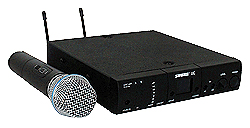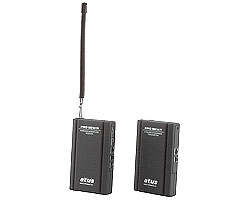|
Sound
> Mikes > Types > Wireless
|

ABOVE: All wireless mikes have a least
2 parts: a transmitter and receiver.
For this handheld wireless, the transmitter
is built into the mike "stick."
BELOW: The subject can plug any mike
she likes into the transmitter (left).
Then, the transmitter is clipped to
the subject. The receiver (right)
is clipped to the camera--and the
audio is routed from the receiver
to the camera's inputs.

|
|
|
"Wireless"
mikes are often configured like lavs or handhelds--the
difference is the subject is not tethered to the camera
with a long wire.
A
wireless mike is--in essence--a very low power FM radio
station. A wire runs from the mike element to a little
transmitter box which is usually attached to the subject's
belt. This transmitter sends the audio signal through
the air (just like a radio station does) to a receiver--which
is typically attached to the camera. Viola--wire-free
operation!
That's
the good part. But there are a few disadvantages to
wireless mikes:
1) Just like an FM radio station, wireless mikes
fade with distance. They work great if you are 15 or
20 feet away--but get much further and things get more
iffy.
2) Just as radio stations sometimes have static,
the wireless mike signal can also be degraded by random
radio noise.
3) Perhaps the biggest downfall is that good
wireless mikes are very expensive--more than a thousand
dollars. You can get a cheapo version at Radio Shack,
but you are rolling the dice. Sometimes these put out
awful quality sound.

|